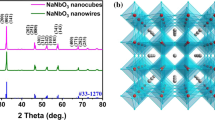Abstract
Co3O4 microtubes with balsam pear-shaped outer surfaces and void spaces were synthesized by the Kirkendall effect. Intermediate phase Li1.47Co3O4 was detected by X-ray diffraction (XRD) to illustrate the severe volume change during electrode reactions and detail the conversion of Co3O4 to Li2O and Co. Changes in and influences on Li2O and Co during the first cycle were explored through calculations based on electrochemical impedance spectroscopy (EIS) tests to obtain a better understanding of the electrode reaction processes. The void spaces in the tube walls accommodated the volume change during electrode reactions, and the balsam pear-shaped outer surfaces expanded the available active surface for electrode reactions. As a result, the prepared Co3O4 microtubes exhibited strong electrochemical performance. The first discharge capacity reached ∼907 mAh g−1 at 5.00 mA cm−2, and discharge capacity remained above 400 mAh g−1 until the 40th cycle at 0.05 mA cm−2.










Similar content being viewed by others
References
Yang ZG, Wang SP (2014) High cycling performance cathode material: interconnected LiFePO4/Carbon nanoparticles fabricated by sol–gel method. J Nanomater. doi:10.1155/2014/801562
Cheng H, Wang SP, Tao D, Wang M (2014) Sulfur/Co3O4 nanotube composite with high performances as cathode materials for lithium sulfur batteries. Funct Mater Lett 7(3). doi:10.1142/s1793604714500209
Cheng H, Wang SP (2014) Recent progress in polymer/sulphur composites as cathodes for rechargeable lithium-sulphur batteries. J Mater Chem A 2(34):13783–13794. doi:10.1039/c4ta02821j
Dong K, Wang SP, Zhang HY, Wu JP (2013) Preparation and electrochemical performance of sulfur-alumina cathode material for lithium-sulfur batteries. Mater Res Bull 48(6):2079–2083. doi:10.1016/j.materresbull.2013.02.031
Zeng J et al (2014) Al and/or Ni-doped nanomanganese dioxide with anisotropic expansion and their electrochemical characterisation in primary Li-MnO2 batteries. J Solid State Electrochem 18(6):1585–1591. doi:10.1007/s10008-013-2372-0
Zeng J, Wang SP, Liu QL, Lei XR (2014) High-capacity V-/Sc-/Ti-doped MnO2 for Li/MnO2 batteries and structural changes at different discharge depths. Electrochim Acta 127:115–122. doi:10.1016/j.electacta.2014.01.167
Zhao HG, Wang SP, Fan LR, Wu JP (2014) The modification of natural pyrite and its electrochemical properties in Li/FeS2 batteries. Funct Mater Lett 7(1). doi:10.1142/s1793604713500690
Liu QL, Wang SP, Tan HB, Yang ZG, Zeng J (2013) Preparation and doping mode of doped LiMn2O4 for Li-Ion batteries. Energies 6(3):1718–1730. doi:10.3390/en6031718
He X et al (2013) Enhanced rate capabilities of Co3O4/carbon nanotube anodes for lithium ion battery applications. J Mater Chem A 1:11121–11125
Li W-Y, Xu L-N, Chen J (2005) Co3O4 Nanomaterials in lithium-ion batteries and gas sensors. Adv Funct Mater 15(5):851–857
Li B et al (2011) Co3O4@ graphene composites as anode materials for high-performance lithium ion batteries. Inorg Chem 50(5):1628–1632
Hao F, Zhang Z, Yin L-W (2013) Co3O4/Carbon aerogel hybrids as anode materials for lithium ion batteries with enhanced electrochemical properties. ACS Appl Mat Interfaces
Xu M et al (2013) Co3O4/Carbon nanotube heterostructures with bead-on-string architecture for enhanced lithium storage performance. Nanoscale 5(17):8067–8072
Sun F, et al. (2012) Hierarchical structure of Co3 O4 nanoparticles on Si nanowires array films for lithium-ion battery applications. Appl Surf Sci
Wang Y et al (2010) Designed functional systems from peapod-like Co@ carbon to Co3O4@ carbon nanocomposites. ACS Nano 4(8):4753–4761
Lou XW, Deng D, Lee JY, Feng J, Archer LA (2008) Self-supported formation of needlelike Co3O4 nanotubes and their application as lithium-ion battery electrodes. Adv Mater 20(2):258–262
Rui X et al (2012) Template-free synthesis of urchin-like Co3 O4 hollow spheres with good lithium storage properties. J Power Sources
Li Y, Tan B, Wu Y (2008) Mesoporous Co3O4 nanowire arrays for lithium ion batteries with high capacity and rate capability. Nano Lett 8(1):265–270
Sun J et al (2013) Free-standing and binder-free lithium-ion electrode based on robust layered assembly of graphene and Co3O4 nanosheets. Nanoscale
Fei Z, He S, Li L, Ji W, Au C-T (2012) Morphology-directed synthesis of Co3O4 nanotubes based on modified Kirkendall effect and its application in CH4 combustion. Chem Commun 48(6):853–855
Kim Y et al (2014) Additive-free hollow-structured Co3O4 nanoparticles Li-Ion battery: the origins of irreversible capacity loss. ACS Nano
Poizot P, Laruelle S, Grugeon S, Dupont L, Tarascon J (2000) Nano-sized transition-metal oxides as negative-electrode materials for lithium-ion batteries. Nature 407(6803):496–499
Laruelle S et al (2002) On the origin of the extra electrochemical capacity displayed by MO/Li cells at low potential. J Electrochem Soc 149(5):A627–A634
Verma P, Maire P, Novák P (2010) A review of the features and analyses of the solid electrolyte interphase in Li-ion batteries. Electrochim Acta 55(22):6332–6341. doi:10.1016/j.electacta.2010.05.072
Van der Ven A, Bhattacharya J, Belak AA (2012) Understanding Li diffusion in Li-intercalation compounds. Acc Chem Res
Larcher D, Sudant G, Leriche JB, Chabre Y, Tarascon JM (2002) The electrochemical reduction of Co3O4 in a lithium cell. J Electrochem Soc 149(3):A234–A241. doi:10.1149/1.1435358
Wang GX et al (2002) Nanosize cobalt oxides as anode materials for lithium-ion batteries. J Alloys Compd 340(1–2):L5–L10. doi:10.1016/s0925-8388(02)00005-1
Grugeon S et al (2001) Particle size effects on the electrochemical performance of copper oxides toward lithium. J Electrochem Soc 148(4):A285–A292
Yan N et al (2012) Co3O4 nanocages for high-performance anode material in lithium-ion batteries. J Phys Chem C 116(12):7227–7235. doi:10.1021/jp2126009
Hoa Nguyen V, Shim J-J (2015) The 3D Co3O4/graphene/nickel foam electrode with enhanced electrochemical performance for supercapacitors. Mater Lett 139(0):377–381. doi:10.1016/j.matlet.2014.10.128
Cui Y, Zhao X, Guo R (2010) Improved electrochemical performance of La0. 7Sr0. 3MnO3 and carbon co-coated LiFePO4 synthesized by freeze-drying process. Electrochim Acta 55(3):922–926
Acknowledgments
This work was supported by the National Natural Science Foundation of China (21173198) and the Natural Science Foundation of Hubei Province, China (2014CFA097).
Author information
Authors and Affiliations
Corresponding author
Rights and permissions
About this article
Cite this article
Yang, Z., Wang, S., Liu, Y. et al. Cobalt oxide microtubes with balsam pear-shaped outer surfaces as anode material for lithium ion batteries. Ionics 21, 2423–2430 (2015). https://doi.org/10.1007/s11581-015-1453-8
Received:
Revised:
Accepted:
Published:
Issue Date:
DOI: https://doi.org/10.1007/s11581-015-1453-8




